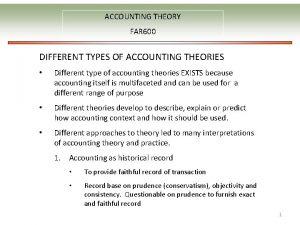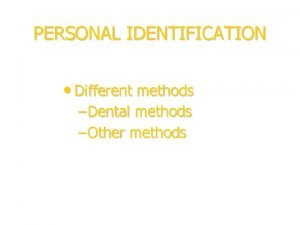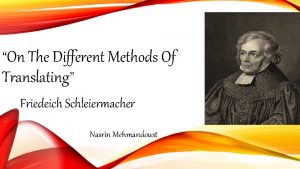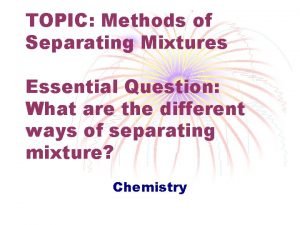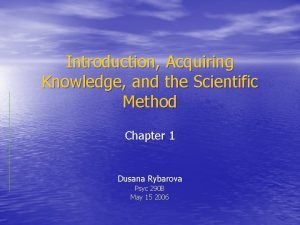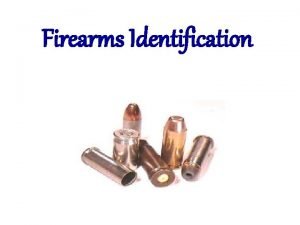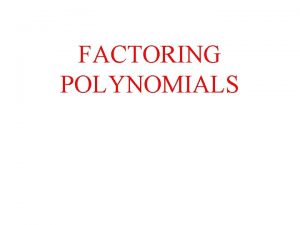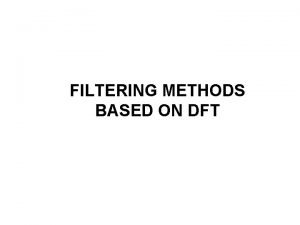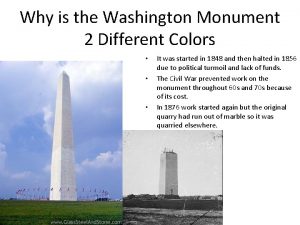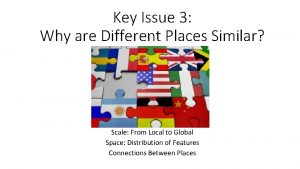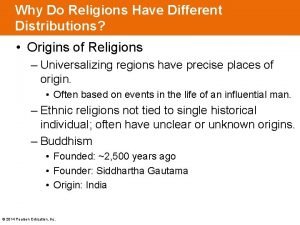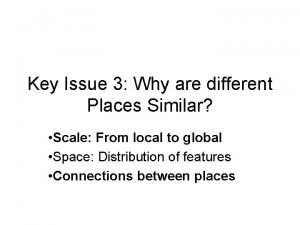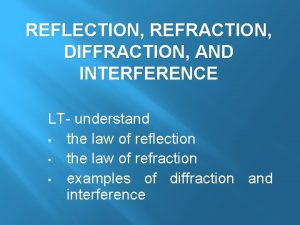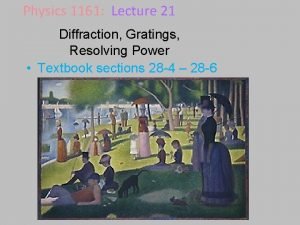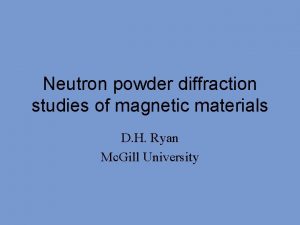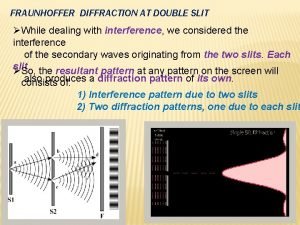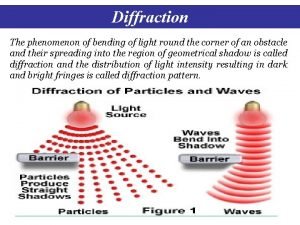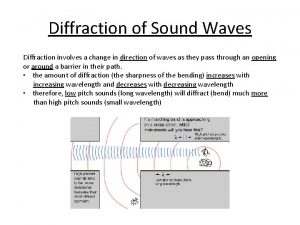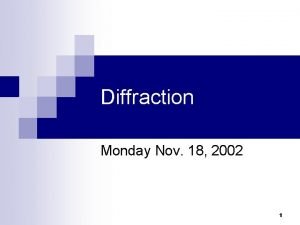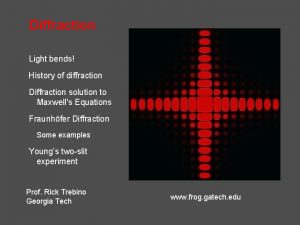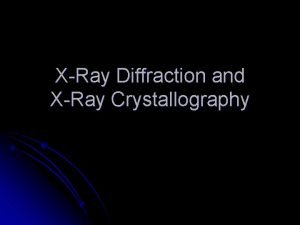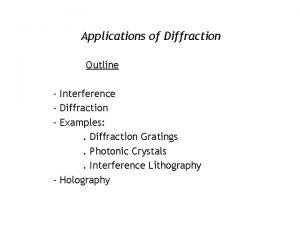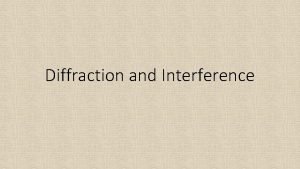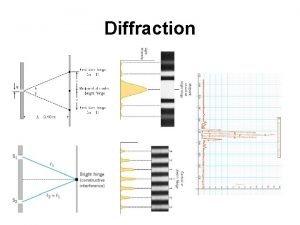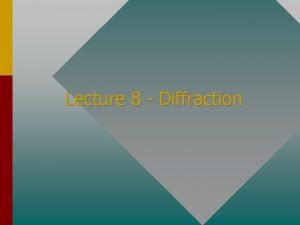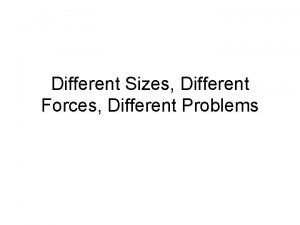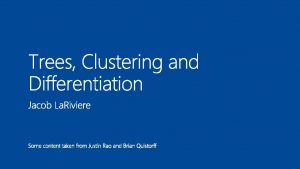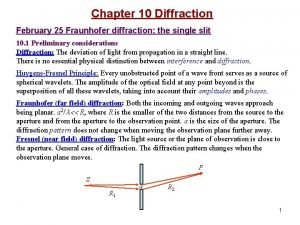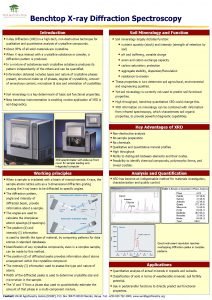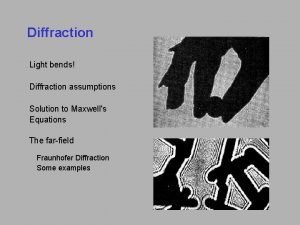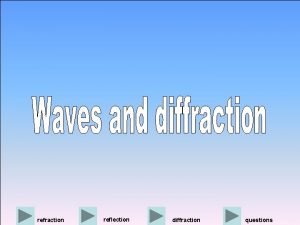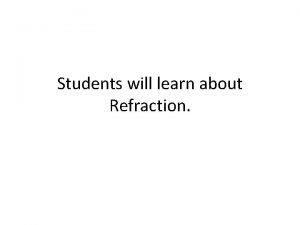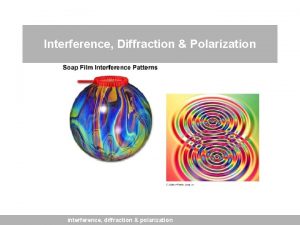diffraction methods diffraction methods Why are different diffraction















































- Slides: 47

diffraction methods

diffraction methods Why are different diffraction methods in use? - depends on the information to be extracted (lattice parameters, crystal structure determination, residual stress measurement, …) - geometry/morphology of the sample - measurement time - additional effects (z. B. fluorescence, in-situ, …) - availability

diffraction methods single crystal diffraction - determination of crystal structures - (symmetry, atomic positions, lattice parameters, …) powder diffraction - phase identifcation - quantitative phase analysis - some remarks on crystal structure (limited by level of complexity)

diffraction methods The Ewald construction 4

diffraction methods Max von Laue 1879 – 1960 Göttingen, Berlin, Zürich, Frankfurt/Main, Würzburg, Berlin 5

diffraction methods Laue method - first of all diffraction methods - verfication of the crystalline state of matter (M. v. Laue) - used for single crystals (reflection or transmission) - uses white beam (polychromatic, usually Bremsstrahlung) - all lattice planes fulfill the diffraction condition simultaneously -> a series of Ewal spheres results: one for each wavelength - sample does not need to be rotated - very quick method (high intensity, parallel diffraction at all lattice planes) used for dynamiacal processes, in situ methods

diffraction methods Ewald construction for polychromatic radiation 7

diffraction methods Laue method - lattice planes select the wavelength for diffraction that fits to their spacing - diffraction spots being diffracted by the same wavelength can be connected by a line -> these points belong to one zone - reflections of planes of one zone lie on the surface of a diffraction cone, whose central axis is the zone axis

diffraction methods Laue method - all diffraction spots on one line have been diffracted by the same wavelength - diffraction spots of lattice plane families have the same position on the screen (100, 200, 300 , /2, /3) - position of the spots is not altered by Dd, but the wavelength at which diffraction takes place

diffraction methods Laue method reflection mode - detector between sample and source - Laue spots are on hyperbolas transmission mode - detector behing sample and source - Laue spots are on ellipses

diffraction methods transmission: diffraction maxima on ellipses 11

diffraction methods reflection: diffraction maxima on hyperbolas 12

diffraction methods Laue method – information content (position) r 1 … distance spot-centre D … distance sample-detector r 2 … distance spot-centre D … distance sample-detector min-Limit transmission Si (001) reflection affected by Compton scattering and diffuse scattering

diffraction methods Laue method – information content (symmetry) Li. Ba. F 3, cubic Li. Ba. F 3, kubisch 2 -fold rotation axis perpendicular to the film 4 -fold rotation axis perpendicular to the film 14

diffraction methods Laue method – information content - determination of crystal orientation - detrmination of the crystal structure (symmetry elements), now mainly for complex crystals, biomolecules - indexing of hkl-positions (Greninger chart, Leonhardt chart), meanwhile automated (needs high calculation power) - shape and size of spots contain information on real structure effects, stress states, etc. - spot positions do not contain information on interplanar distances, this is stored in the energy of the diffraction spot

diffraction methods Laue method – spot shape (for perfect crystals) - governed mainly by condition of the primary beam (divergence) slight changes of the Bragg angles due to divergence in transmission, divergent beam is focused due to diffraction no focusing in perpendicular direction: elliptical spot shape - no focusing in reflection mode (divergence: spot size increases with distance from direct beam)

diffraction methods Laue method – spot shape (for perfect crystals) ‚lines‘ instead of spots in the reciprocal lattice min: min hkl max: max hkl 17

diffraction methods Laue method determination of the angles (angle in the diffraction plane) and (angle perpendicular to diffraction plane) with the aid of the stereographic net 18

diffraction methods Ewald construction for singly crystal and monochromatic beam diffraction only for certain combinations of diffraction angle (2 ) and orientation of the crystal with monochromatic radiation: only ONE Ewald sphere 19

diffraction methods rotating crystal method - monochromatic radiation crystal rotates perpendicular to the beam around one of its crystallographic axes cylindrical film as detector determination of lattice parameters of single crystals - reciprocal lattice points spherically cut the Ewald sphere, when they are located on planes perpendicular to the rotation axis of the crystal - diffracted rays lie on cones (Laue cones – axis along rotation axis) - cone opening = f( , dhkl) - on the cylindrical film: spots along lines are observed disadvantages: - no information on symmstry of the crystal (destroyed by measurement principle) - no unambiguous indexing of reflections possible

diffraction methods rotating crystal method

diffraction methods rotating crystal method 22

diffraction methods Weissenberg camera (evolution of the rotating crystal method) - monochromatic radiation - crystal rotates perpendicular to the beam around one of its crystallographic axes - cylindrical film as detector as for rotating crystal method - rotation of the crystal is superimposed by motion of the detector parallel to the rotation axis -> reflection spread out and can be indexed - solution of crystal structures - correct measurement of spot intensities - a set of equidistant reciprocal lattice planes (one Laue cone) is selected by a slit and produces diffraction maxima on the film

diffraction methods Weissenberg camera (evolution of the rotating crystal method)

diffraction methods single crystal diffractometer - monochromatic radiation, 2 D detector if possible

diffraction methods single crystal diffractometer Drehung um F - 2 independent rotations suffice to move any reciprocal lattice point on the surface of the Ewald sphere (=diffraction condition) - move crystal into Bragg condition - problem: large diffractometer setup, Eulerian cradle may block some of the Laue spots Kappa-geometry Drehung um c

diffraction methods single crystal difractometer

diffraction methods single crystal diffractometer – information content - How to find reflections on the detector? - Which reflections are observed? - multiple coordiante systems are involved (crystal, goniometer, lab) - rotation matrices are used to mutually convert the coordinate systems (contain the relevant angles) - orientation matrix can be calculated from the spot positions, or can be used to find spots - orientation matrix obtained from metric tensor - determination of the integral intensity - scan of the whole reciprocal lattice point (w-scan; 2 -scan)

diffraction methods structural analysis of single crystals with a 4 -circle diffractometer Ø Ø Ø Ø investigation of the reciprocal space determination of lattice parameters analysis of extinct reflections (subtranslations in the crystal lattice) measurement of diffracted intensities (symmetry of the crystal lattice) selection of the space group approximation of the atomic positions (Patterson function, direct methods) structure solution (lattice parameters, atom positions, thermal vibrations of atoms) 29

diffraction methods single crystal diffractometer – 2 D detector - a large portion of reciprocal space can be simultaneously measured critically depends on the choice of D (detector, , unit cell)

diffraction methods single crystal diffractometer – informatio content - crystal is rotated detector is moved to different positions to collect different diffraction images diffraction image typically shows some symmetry equivalent reflections automated data reduction and analysis to extract crystal orientation, space froup and lattice parameters - problematic for crystals with high symmetry and small unit cells Lattice parameters of omphacite (Ca 0. 51 Na 0. 48)(Mg 0. 44 Al 0. 44 Fe 2+0. 14 Fe 3+0. 02)Si 2 O 6 at 0. 35 GPa http: //cloudflare. jove. com/files/ftp_upload/54660 fig 8 large. jpg

diffraction methods powder methods

diffraction methods powder methods – What is a ‚powder‘? - large number (> 106… 107) of randomly orientend ‚coherently diffracting domains‘ - reciprocal lattice points transformto spheres (superposition of all crystal orientations, r* = reciprocal interplanar distance) - diffraction maxima at intersection of Ewald sphere and sphere of ‚reciprocal lattice points‘ Laue-cones diffraction is on every point of their surface

diffraction methods powder methods – What is a ‚powderÄ?

diffraction methods powder methods - intensity distribution along the rings homogeneous (powder condition) each infinitesimally small section of the Debye ring contains the same information - can be improved by sample rotation - relative intensities are strongly affected by powder statistics (one of the biggest problems of this method) - angle-dispersive: monochromatic radiation, determination of diffraction angle through detector motion - energy-dispersive: white beam, fixed diffraction angle, determination of diffraction angle through energy scanning (cf. Laue method, Bragg equation) -> requires energy sensitive detector, mostly at synchrotrons, in situ methods

diffraction methods Debye-Scherrer camera - direct imaging of the rings with transmission or backscattering cameras - limited to small or large diffraction angles Debye-Scherrer camera

diffraction methods Debye-Scherrer camera - Laue cones are image on a film as Debye rings - cameras register only a small section of the whole ring - all diffraction angles are measured simulaneously

diffraction methods Debye-Scherrer camera - large camera increases resolution - but creates more background noise (air scattering), requires longer exposure - lines in Debye-Scherrer cameras usually suffer from large instrumental broadening (beam divergence, sample dimensions, size of camera)

17/10/2012 (71 st sol) diffraction methods transmission, powder diffraction, Co-Ka radation feldspar, pyroxene, olivine (similar to volcanic rocks on Hawaii) Debye-Scherrer camera https: //en. wikipedia. org/wiki/Rocknest_(Mars) 1 st diffraction pattern of Martian soil Che. Min experiment (Curiosity Rover, NASA) https: //photojournal. jpl. nasa. gov/catalog/PIA 16217

diffraction methods focussing geometries - sample is moved from the centre of the diffractometer to the edge (goniometer circle) - requires bbent samples to focus the beam into the detector opening - goal: sharp diffraction lines Seeman-Bohlin geometry - reflection mode - divergent beam Guinier geometry - transmission mode - convergent beam limited 2 ranges for both geometries

diffraction methods focussing geometries Guinier Seemann and Bohlin - constant radius of focussing circle - change in distance sample - detector hier bent PSDs can be used - 2 = 0 cannot be reached (complex alignment) 41

diffraction methods powder diffractometers - use the same principle as cameras for powder diffraction - measure 2 angle and intensity of a small section of the Debye ring in reciprocal space - disadvantage (cmp. to cameras): longer measurement times (sequential measurement) - measurement design: variation of 2 + registration of intensity - each peak corresponds to an intersection with a Debye ringe/Laue cone

diffraction methods powder diffractometer (state of the art) - parafocussing geometry: Bragg-Brentano geometry

diffraction methods powder diffractometer (state of the art) - parafocussing geometry: Bragg-Brentano geometry 44

diffraction methods powder diffractometers - parafocussing: (‚Umfangswinkelsatz‘) all divergent rays of the source are focussed via reflection into the receiving slit - films cannot be used with this geometry - derivative of the Seeman-Bohlin geometry: flat sample - detector moves in 2 around the sampl, at distance R (= distance source-sample) - since detector travels along the diffractometer circle, sample has to be rotated with half the angular speed in order to be the tangent on the focussing circle - radius of focussing circle changes with 2 - parafocussing is limited to 2 = x°… 160° - errors through flat sample/change in radius of focussing circle neglected - vertical or horizontal setup motion of source and detector ( - ) or sample and detector ( -2 ) continuous or stepwise measurement of intenisty transmission or reflection geometry

diffraction methods Bragg-Brentano geometry

diffraction methods other methods - glancing angle/asymmetric diffraction geometries ( -2 diffractometer) - constant pentration depth - requires parallel beam - residual stress measurment (4 -circle goniometer) measurement of preferred orientation (4 -circle goniometer) non-coplanar geometries X-ray reflectometry …
 Antigentest åre
Antigentest åre Andreas carlsson bye bye bye
Andreas carlsson bye bye bye Thermosoftening plastics examples
Thermosoftening plastics examples Technicolor test
Technicolor test Dont ask
Dont ask Sound will travel at different speeds in different mediums.
Sound will travel at different speeds in different mediums. Lrefraction
Lrefraction Cultural relativism
Cultural relativism Different angle different story
Different angle different story Acids and bases have two different faces
Acids and bases have two different faces Manufactured boards examples
Manufactured boards examples Different people different things
Different people different things Argumenterande tal struktur
Argumenterande tal struktur Hexokinase method advantages and disadvantages
Hexokinase method advantages and disadvantages What are the objectives of size separation
What are the objectives of size separation Different types of accounting methods
Different types of accounting methods Different methods of personal identification
Different methods of personal identification On the different methods of translating
On the different methods of translating Different types of errors in numerical methods
Different types of errors in numerical methods Different methods of adulteration of crude drugs
Different methods of adulteration of crude drugs Centrifuge separating mixtures
Centrifuge separating mixtures Direct or expository approach
Direct or expository approach Ways of acquiring knowledge
Ways of acquiring knowledge Bullet anatomy
Bullet anatomy Recall the different methods of factoring polynomials
Recall the different methods of factoring polynomials Different methods of fish preservation
Different methods of fish preservation Methods of presenting information
Methods of presenting information Filtering methods based on dft
Filtering methods based on dft Direct wax pattern technique
Direct wax pattern technique Washington monument different color
Washington monument different color Why everyone voice is different
Why everyone voice is different Why are different places similar?
Why are different places similar? Why do religions have different distributions
Why do religions have different distributions Why are different places similar?
Why are different places similar? Why does business exist
Why does business exist Plants have different parts
Plants have different parts Why do plants have different parts
Why do plants have different parts Resolving power equation
Resolving power equation Reflection refraction diffraction interference
Reflection refraction diffraction interference Reflection refraction diffraction
Reflection refraction diffraction Multiple slits diffraction
Multiple slits diffraction 642008419
642008419 Absent spectra in diffraction grating
Absent spectra in diffraction grating Dispersive power of grating is directly proportional to
Dispersive power of grating is directly proportional to Principal maxima and secondary maxima
Principal maxima and secondary maxima Sound diffraction
Sound diffraction Fraunhofer and fresnel diffraction
Fraunhofer and fresnel diffraction Diffraction of light
Diffraction of light















